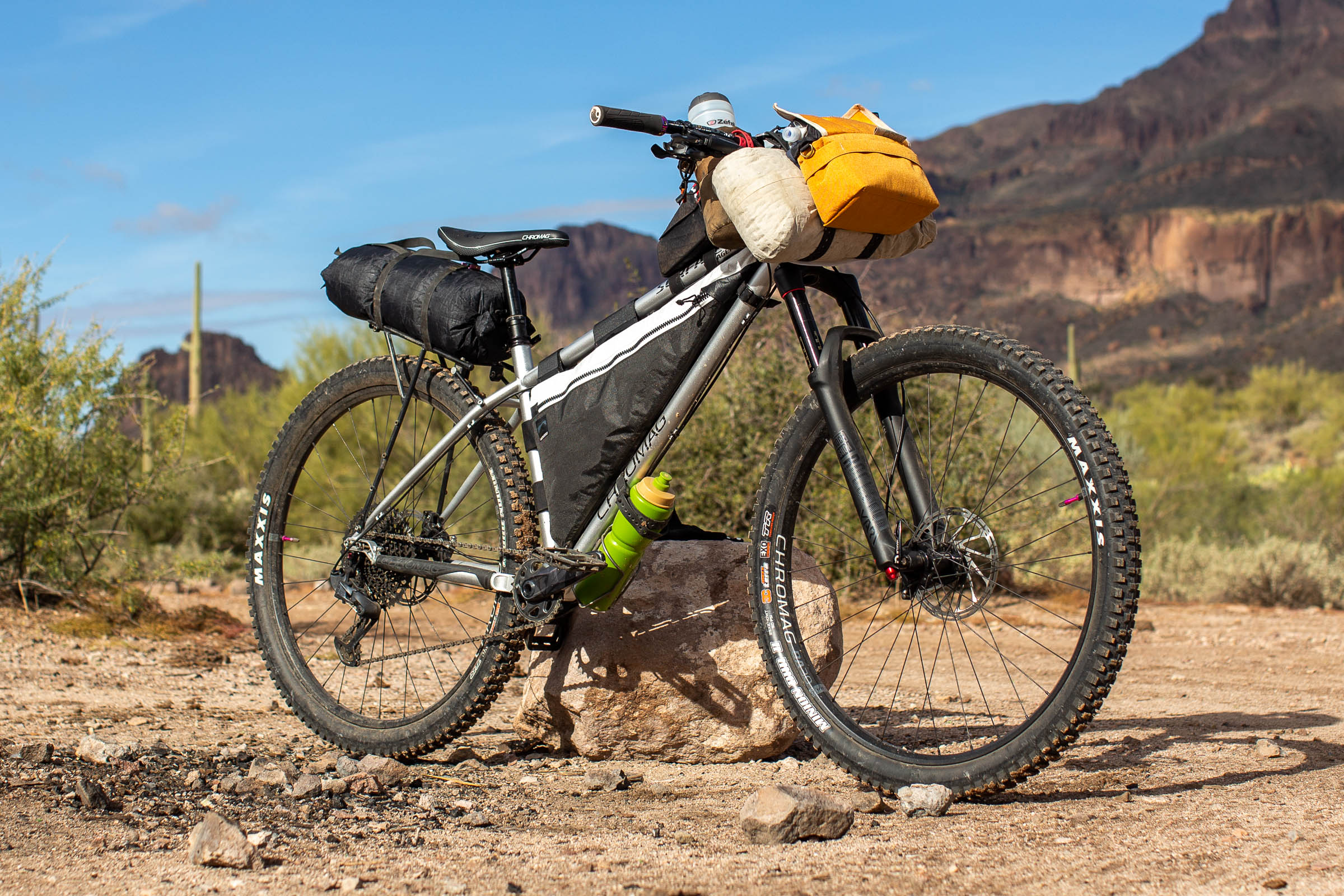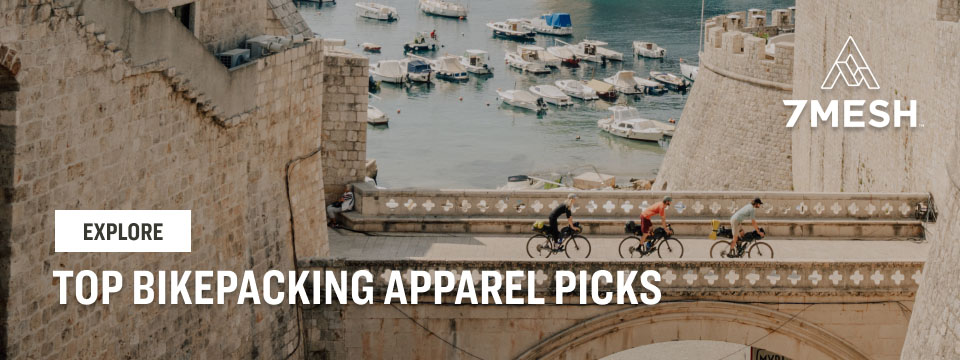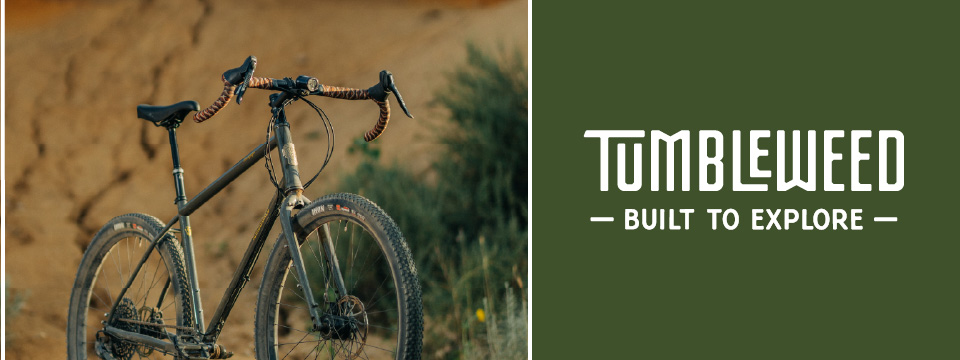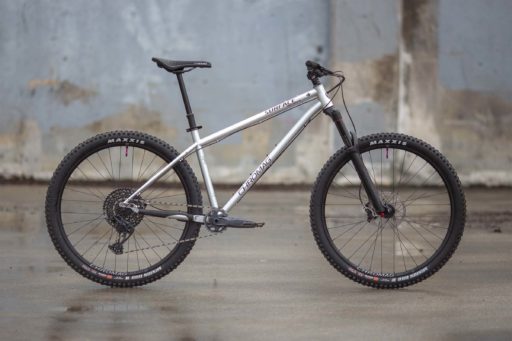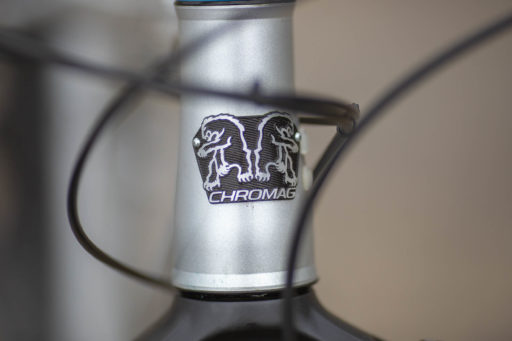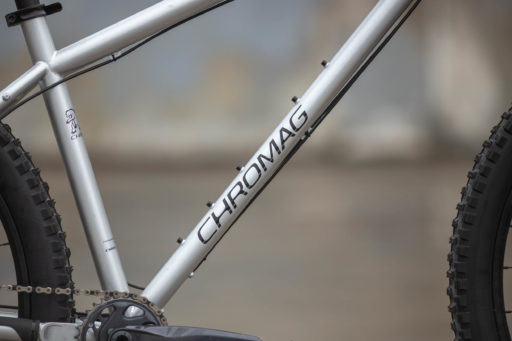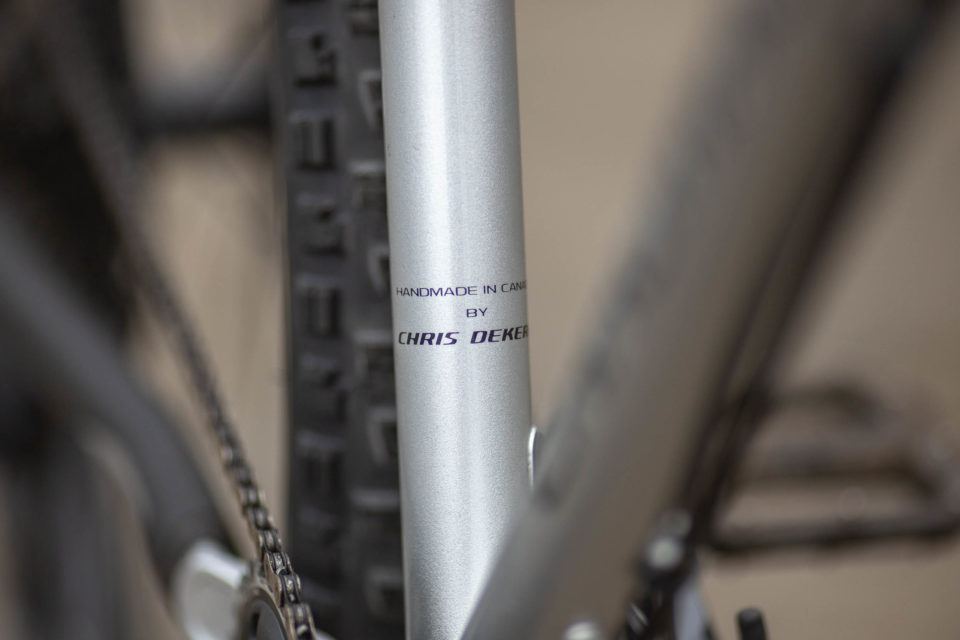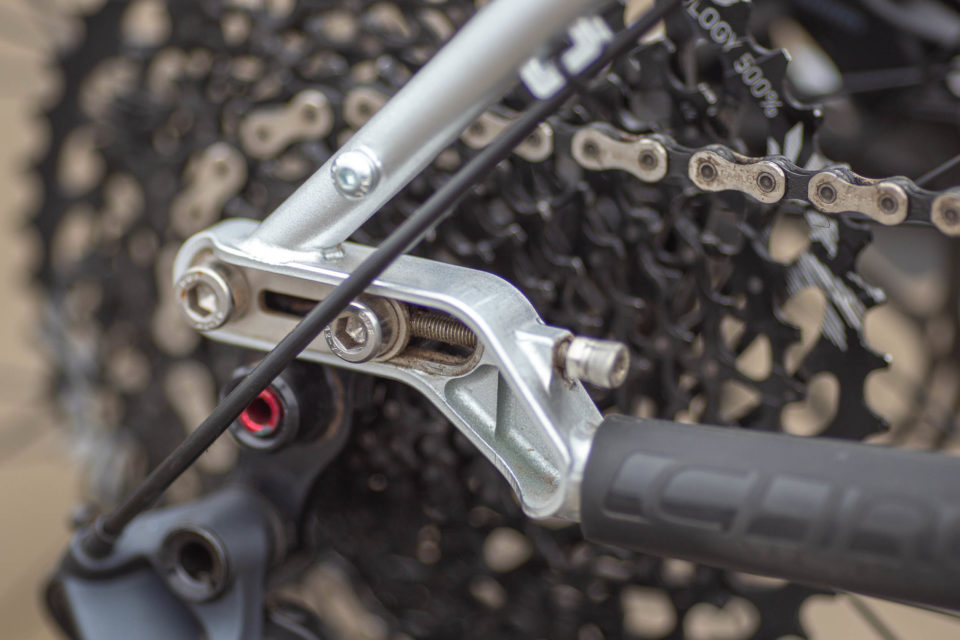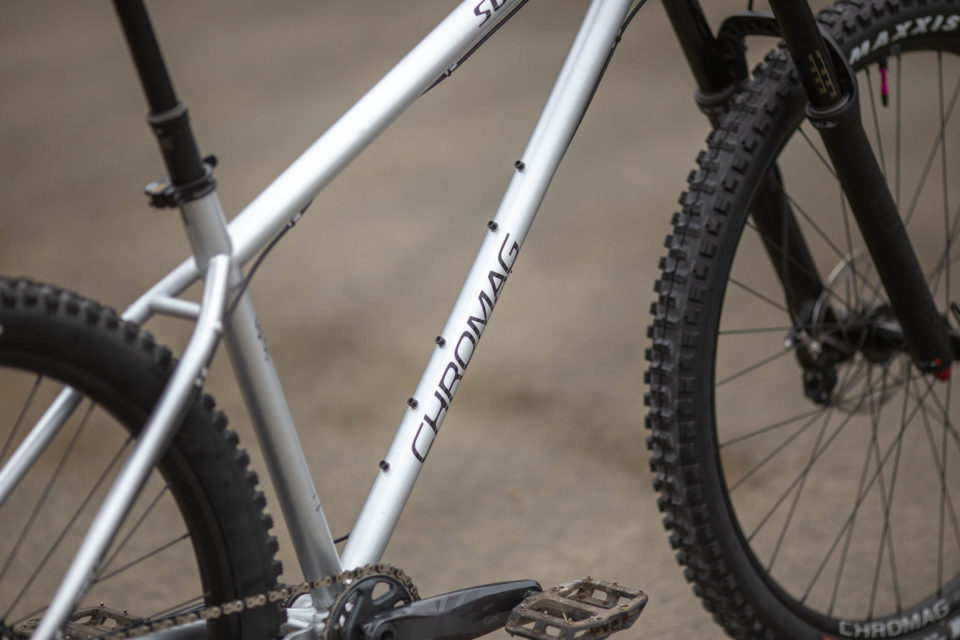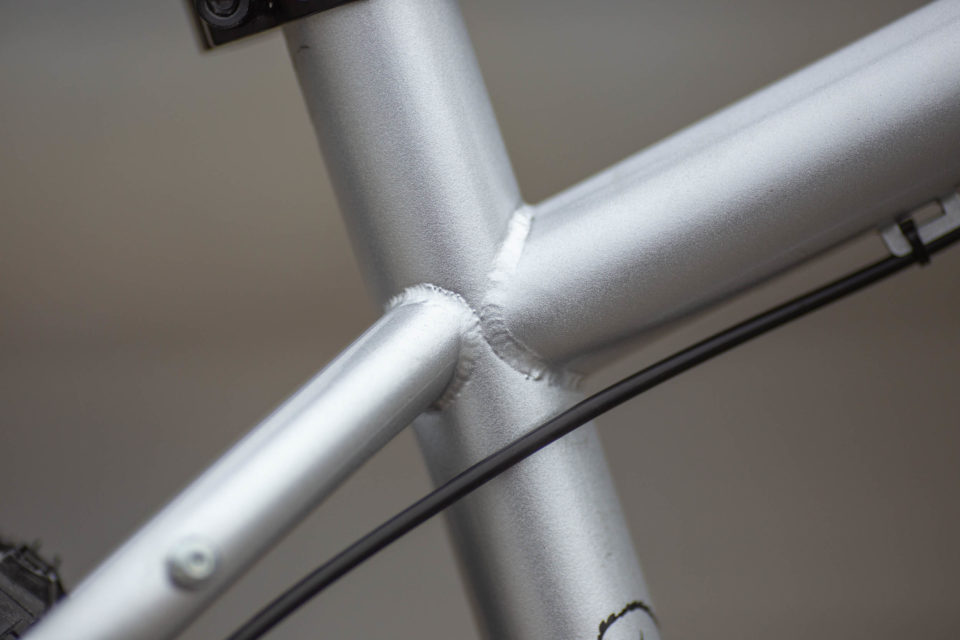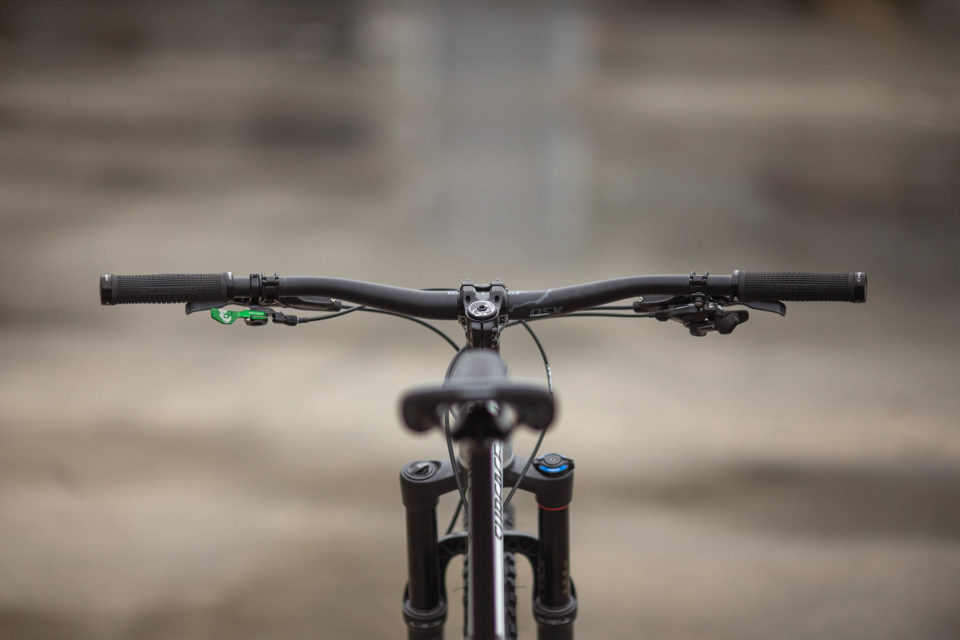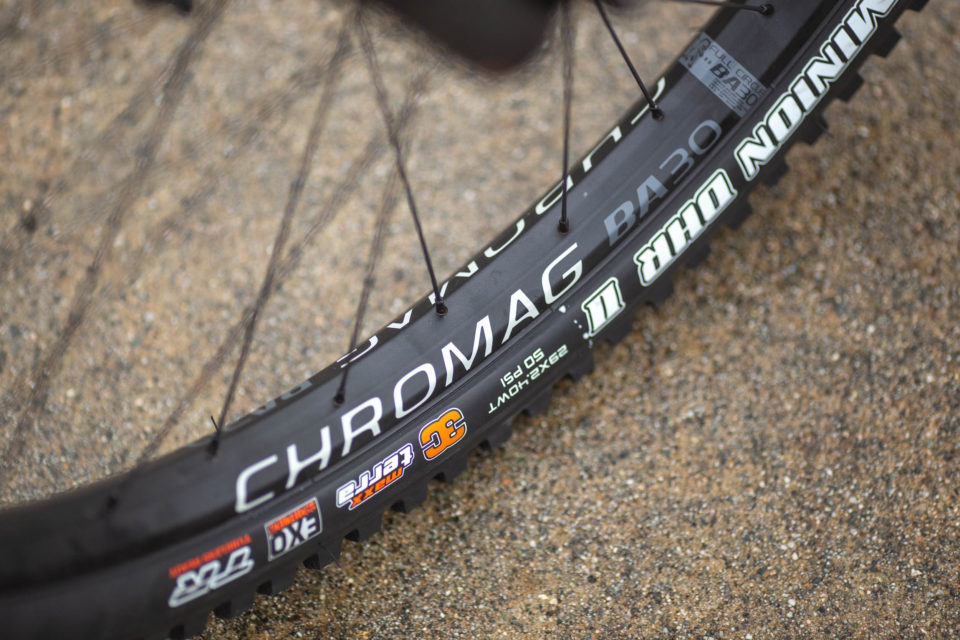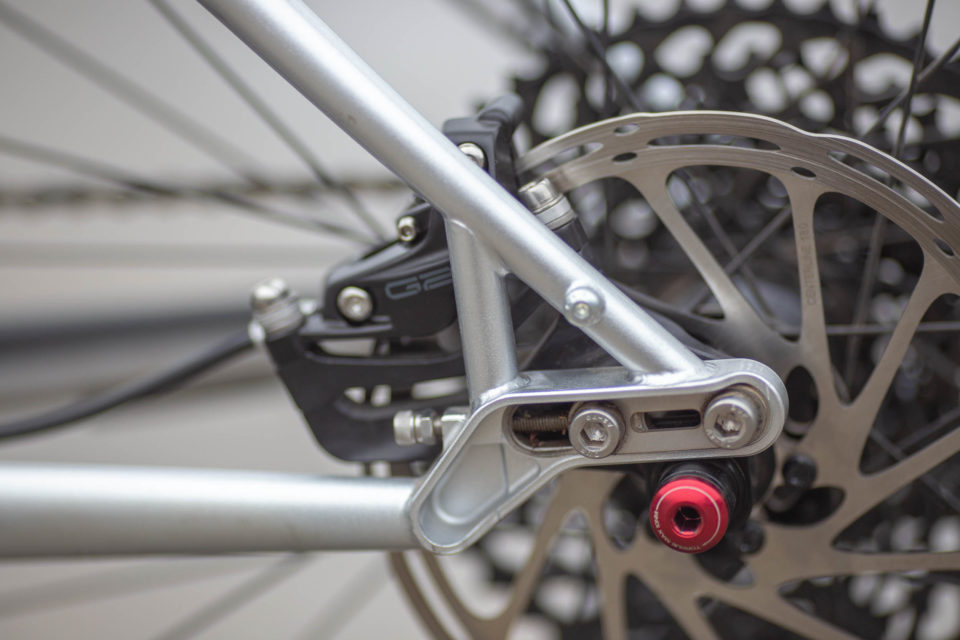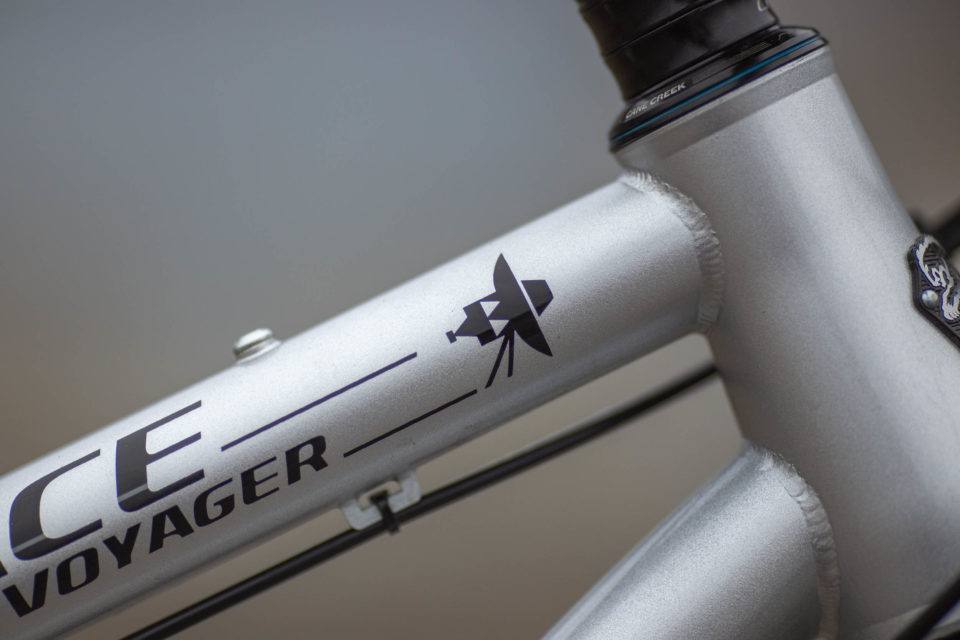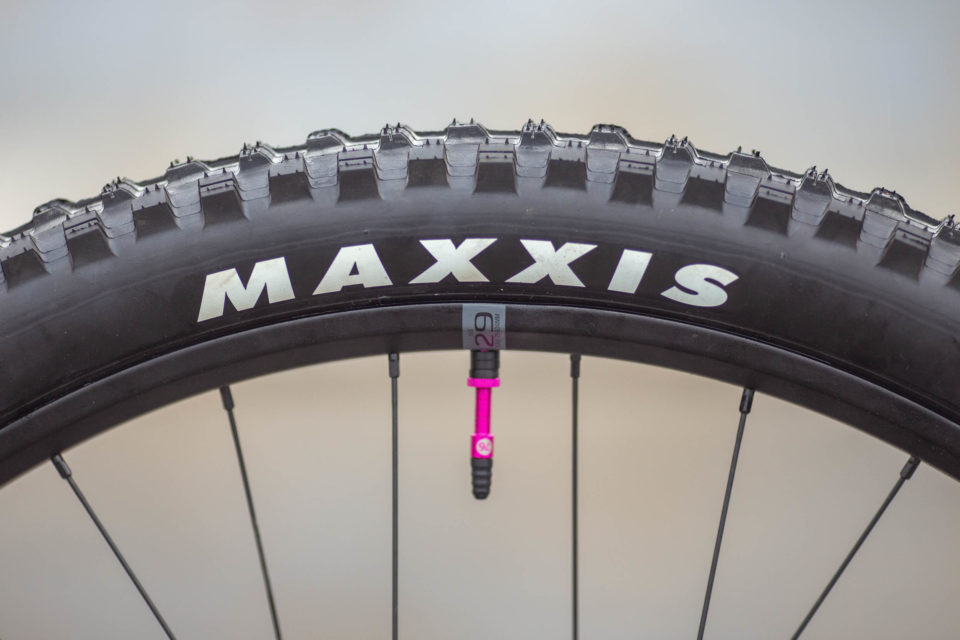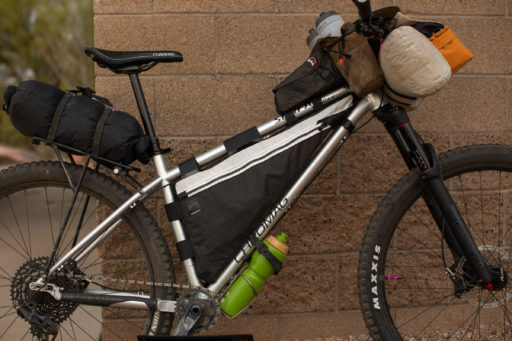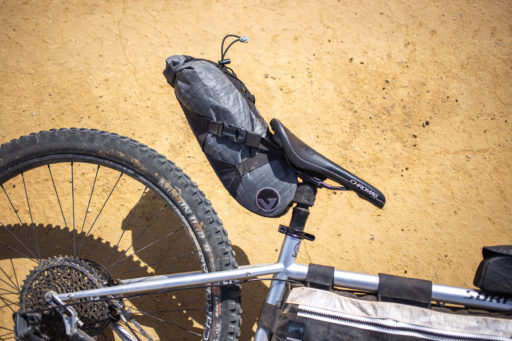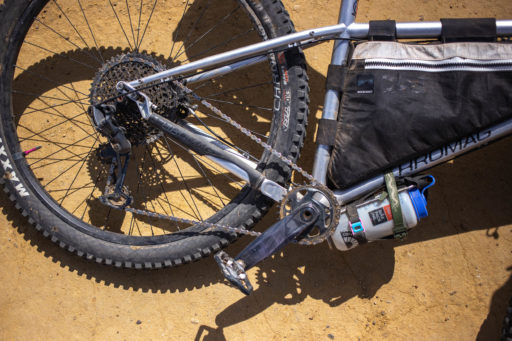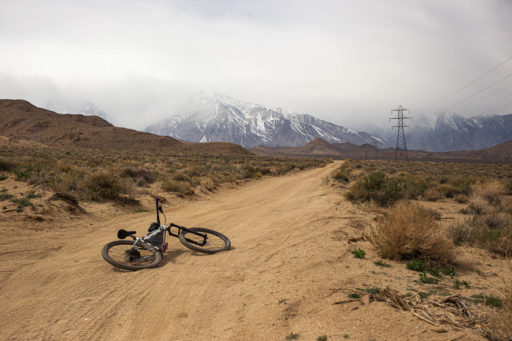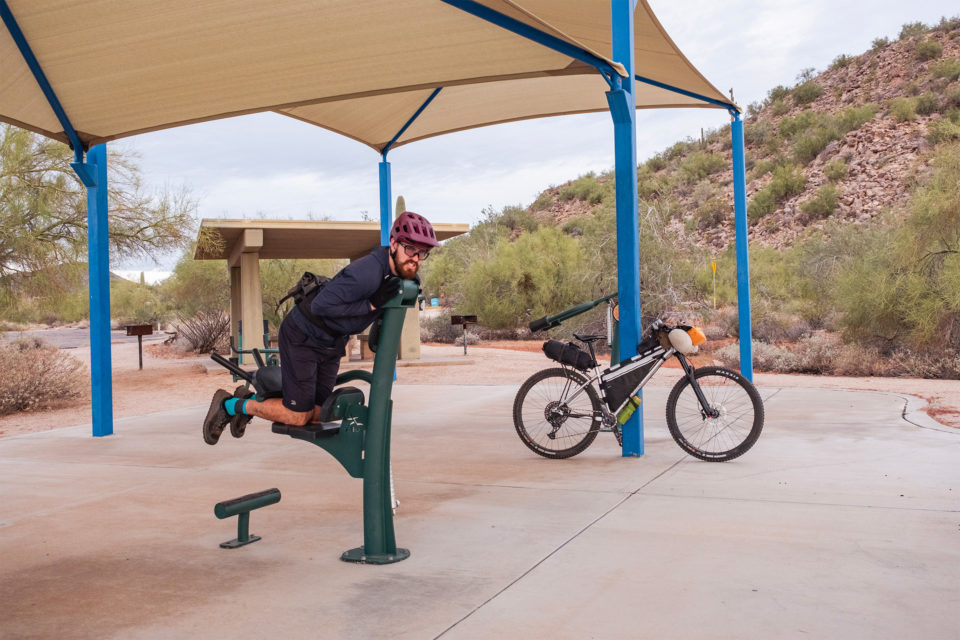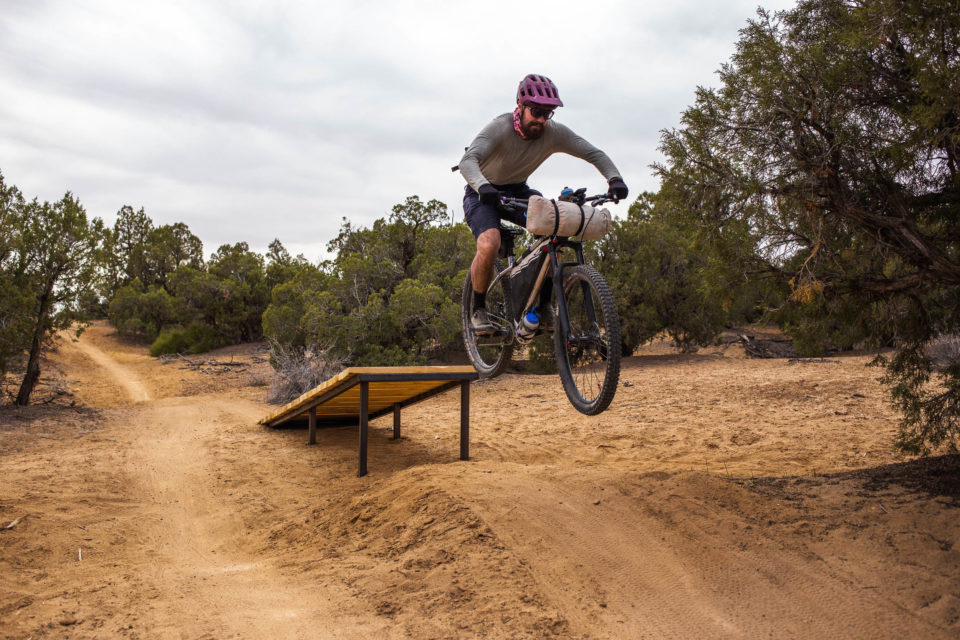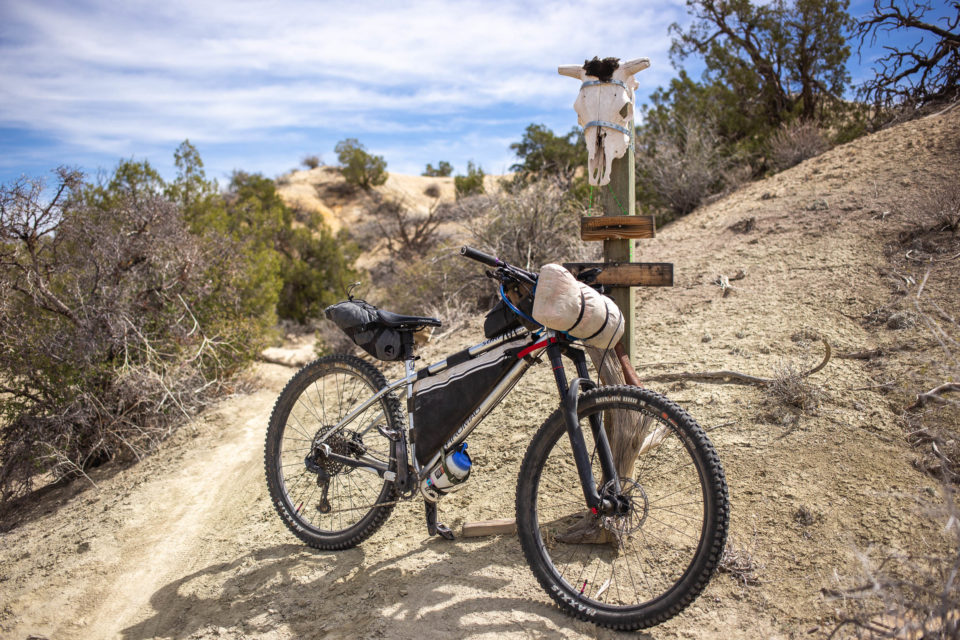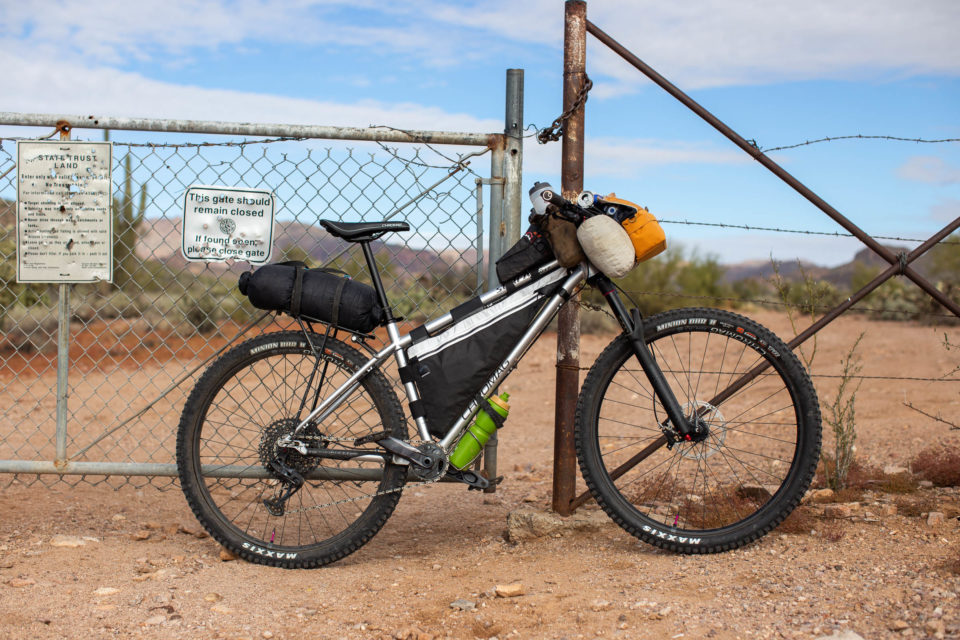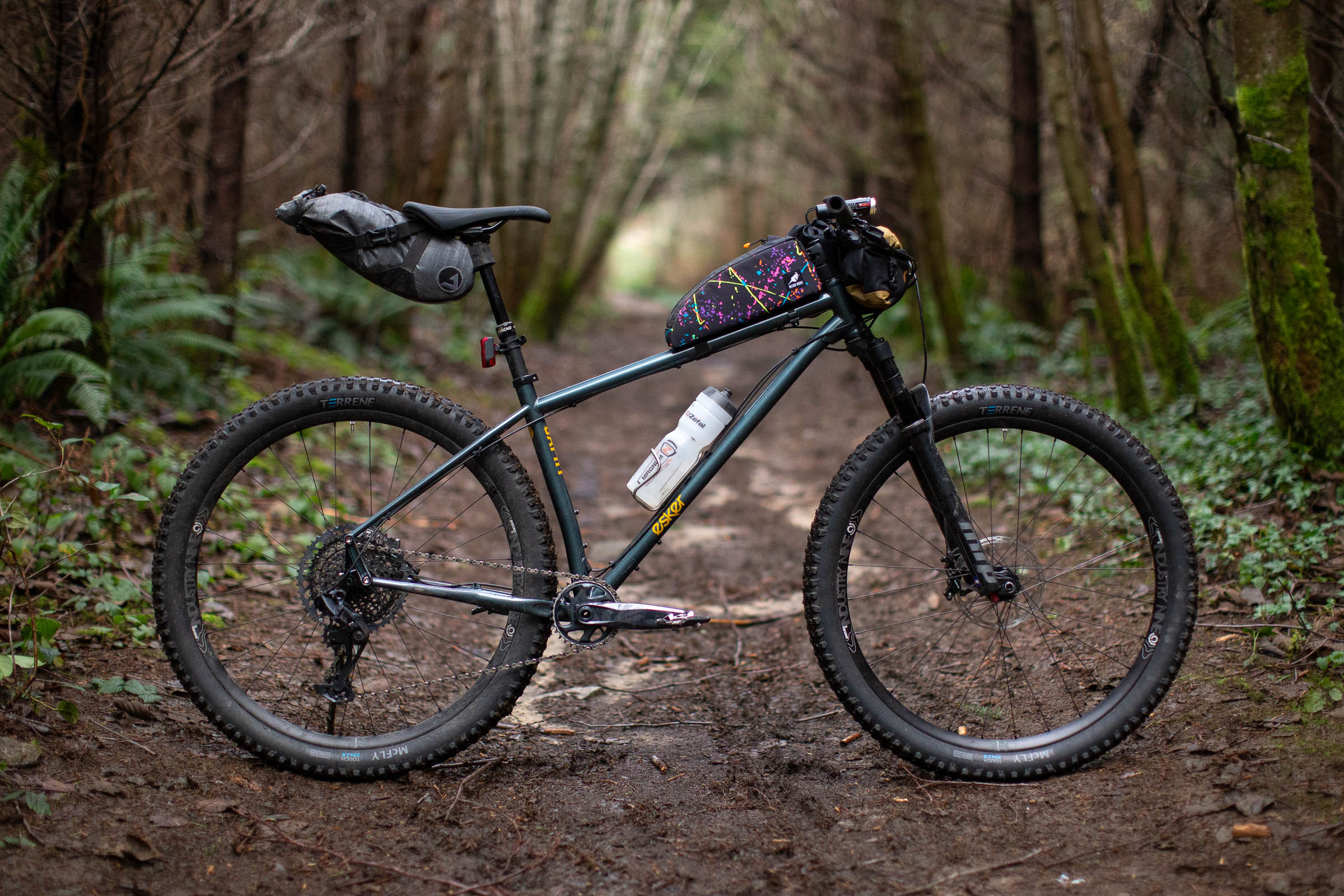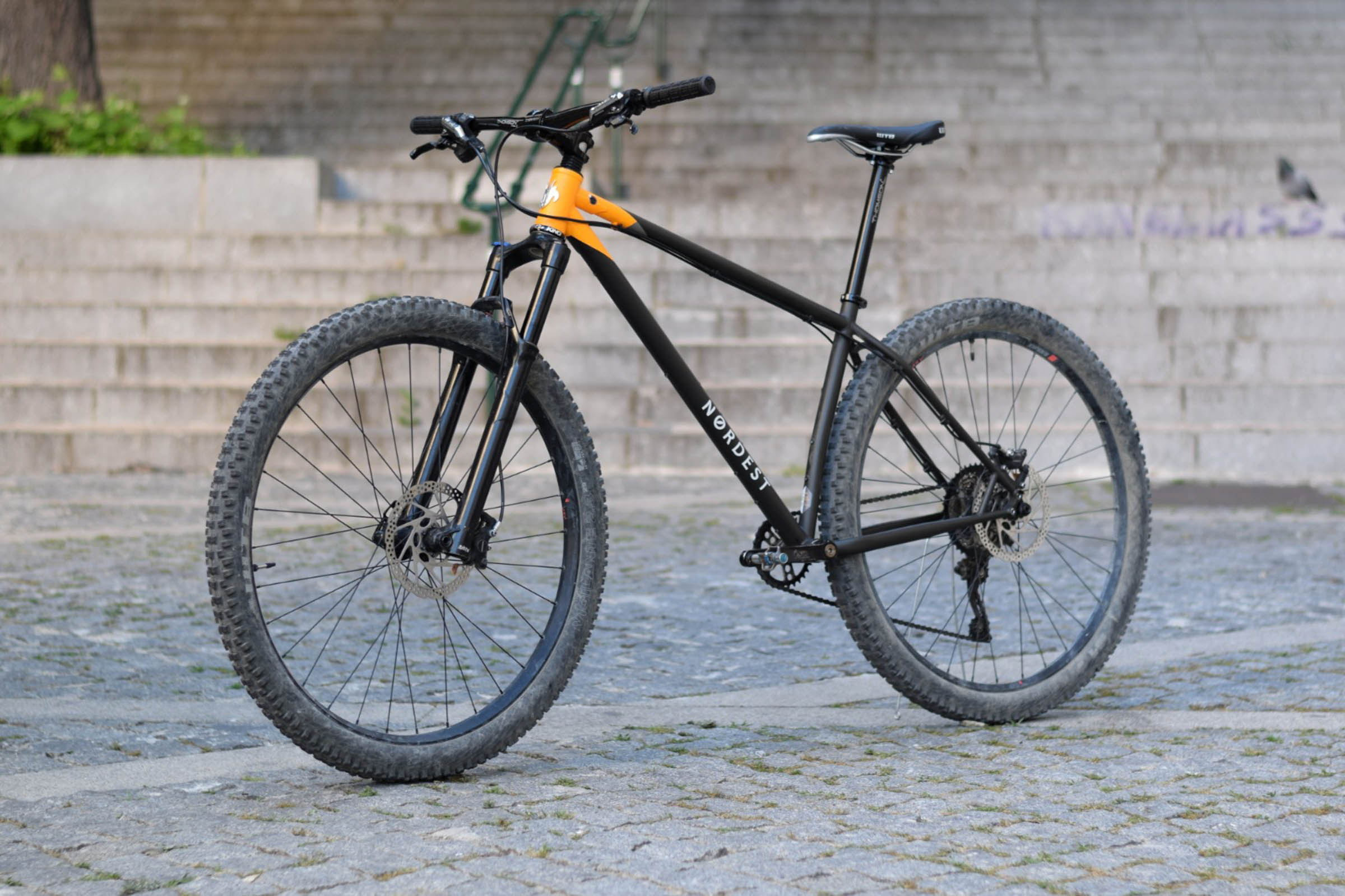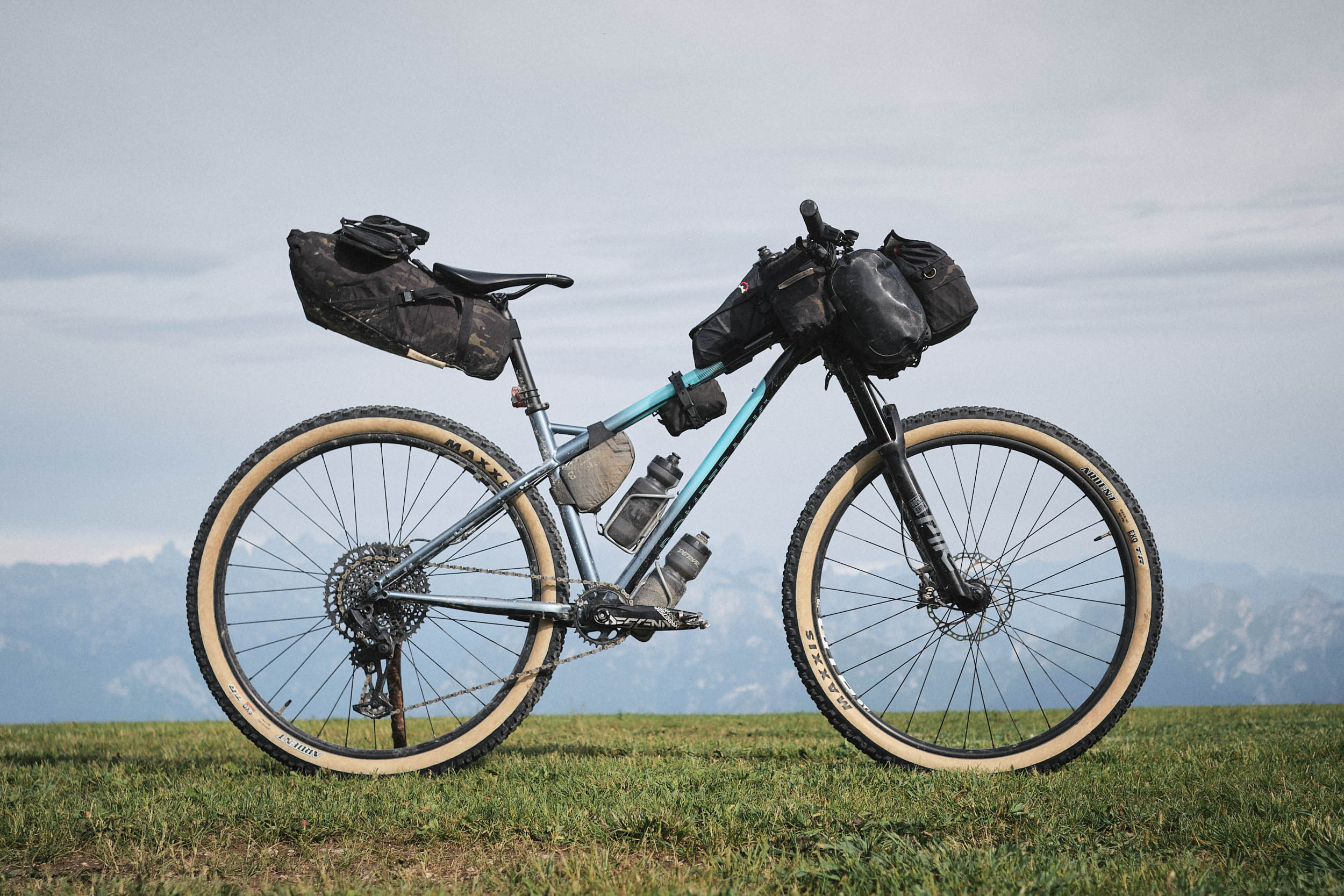Chromag Surface Voyager Review: Canadian Shredpacker
Share This
Released last summer, the Chromag Surface Voyager is a Canadian-made rowdy steel hardtail with several new tricks that make it look pretty appealing as a backcountry bikepacking rig. Miles has been testing one for nearly five months, from hot laps in BC to scouting new routes in the American Southwest. Read his in-depth review here…
If you read my review of the Panorama Taiga (linked at the bottom of this post), you’re likely familiar with this new breed of mountain bike I affectionately refer to as “semi-rad steel hardtails.” To summarize, they fall somewhere between dirt road tourers and ultra-slack hardtails—think Marin Pine Mountain, Nordest Britango, Esker Japhy, and Mason Raw. The big takeaway is that these bikes hit a sweet spot for general trail riding and bikepacking. For anyone coming from an older bike, modern semi-rad geometry is easy to figure out and usually feels equally solid as a loaded bikepacking bike as it does for post-work rips.
While that’s all fine and dandy, it turns out there’s another category of steel hardtail that leans closer toward the rad side of things: the shredpacker’s delight. Generally, bikes in this category have a longer reach, taller stack height, and slacker head tube angle (in the 64° to 66° range). They normally fall into the all-mountain/enduro category, and for the most part, don’t quite have all the specs that bikepackers typically look for. Rear rack mounts become even more uncommon, extra bosses are omitted, and most use non-sliding dropouts. All shred, no pack.

Enter the Chromag Surface Voyager. Released last summer, the Surface Voyager is a completely redesigned version of the original Surface. It’s based around the same platform but received a major overhaul to bring it closer to its roots as a hardtail for travelling far and wide. While Chromag describes it as being “a little less forked” than their more aggressive models, the Surface Voyager doesn’t stray too far from what they know—which includes a long reach, a fairly high stack, and aggressive (but not overly so) 65.5° head tube angle and 76° seat tube angle.
- Highlights (Large)
- Angles: 65.5° Headtube, 76° Seattube
- Chainstay: 425-440mm
- Bottom Bracket: 73mm Threaded
- Hub specs: 15 X 110mm (front); 12 X 148mm (rear)
- Seatpost Diameter: 31.6mm
- Max Tire Size: 29 x 2.6″ / 27.5 x 2.8″
- Price: $6,000 CAD (~$5,131 USD)
Its 4130 Chromoly Steel frame is designed for use with a 140mm travel fork, boost hub spacing, and modular sliding dropouts. The Surface Voyager is loaded with features that bikepackers will surely appreciate, including externally routed cables, multiple mounts inside the main triangle, top tube and downtube mounts (a first for Chromag), and rear rack mounts. As always, it uses a 73mm threaded bottom bracket, Chromag’s own “Yokel” chainstay bridge, and an injection moulded chainstay protector. The Surface Voyager is the only bike in Chromag’s current lineup that has sliding dropouts, rear rack mounts, and multiple bottles mounts.
Each Surface Voyager frame is hand-made in Canada by Chris Dekerf, a BC-based master frame builder with more than 30 years of experience. While custom, one-off frames are Chris’ specialty, his company was actually founded on building frames for other companies, including Rocky Mountain, Off Road Toad, and more recently, Chromag Bikes. He’s also done OEM painting for companies such as Cervelo, Knolly, and others. As such, the overall quality and craftsmanship of the frame are top-notch. Each perfectly uniform weld is a telltale sign of the attention to detail and skill Chris brings to the table.
Currently, the Surface Voyager is available as a frame only for $2,480 CAD (~$2,121 USD) or as the G2 Better Build for an even $6,000 CAD (~$5,131 USD). They sent me a variation on their G2 Better Build, built up around a 1×12 drivetrain and an assortment of their own components. Out of respect for Chromag’s rowdy nature, I’ve thrown everything I’ve got at it. From hot laps in British Columbia to scouting the Queen’s Ransom route in Arizona, as well as the newly published San Juan Space Jam in northwestern New Mexico. Five months of unloaded trail riding, lots of loaded bikepacking, and a variety of configurations, including rear racks, high-volume long flap handlebar bags, and more svelte trail kits.
From Semi-Rad to Shred-Pack
As mentioned earlier, the Surface Voyager leans closer to the rad side of the spectrum when compared to other steel hardtails we’ve tested. In fact, from a strictly geometry-based standpoint, it’s easily the rowdiest, most downhill-oriented bike we’ve reviewed here on the website. A 66.5° headtube angle isn’t exactly steep, and the 76° seat tube angle and 487mm reach (size large) aren’t specs we usually see in the bikepacking world. Fortunately, it’s not just another rowdy steel hardtail, as Chromag already offers a full lineup of those.
Rather, they purposefully designed the Surface Voyager for loading up and going further, and although the geometry might look a little aggressive, there’s more to it than meets the eye. First off, it has mounting points that are normally left off bikes in this genre. Dedicated upper and lower rear rack mounts are a big plus, allowing the option to run a lightweight rack for unobstructed dropper post use. Although you won’t find bottle mounts on the seat tube yet, Chromag did double up with bosses on the downtube plus an additional set underneath. They even threw in some top tube bosses for good measure. While other hardtails’ seat tubes have been getting shorter and shorter over the years, Chromag kept the Voyager’s slightly longer, providing a reasonable but not massive amount of room for a frame bag. Due to the lack of seat tube bosses, a full frame bag makes a lot of sense.
It’s promising to see sliding dropouts, externally routed cables, a threaded bottom bracket, and any Canucks reading will surely appreciate the Canadian-made 4130 Chromoly steel frame. When it comes to the Surface Voyager, it’s clear Chromag stuck with what they know best, but added a few selected, thoughtfully chosen features for bikepacking. The question is, did they get it right?
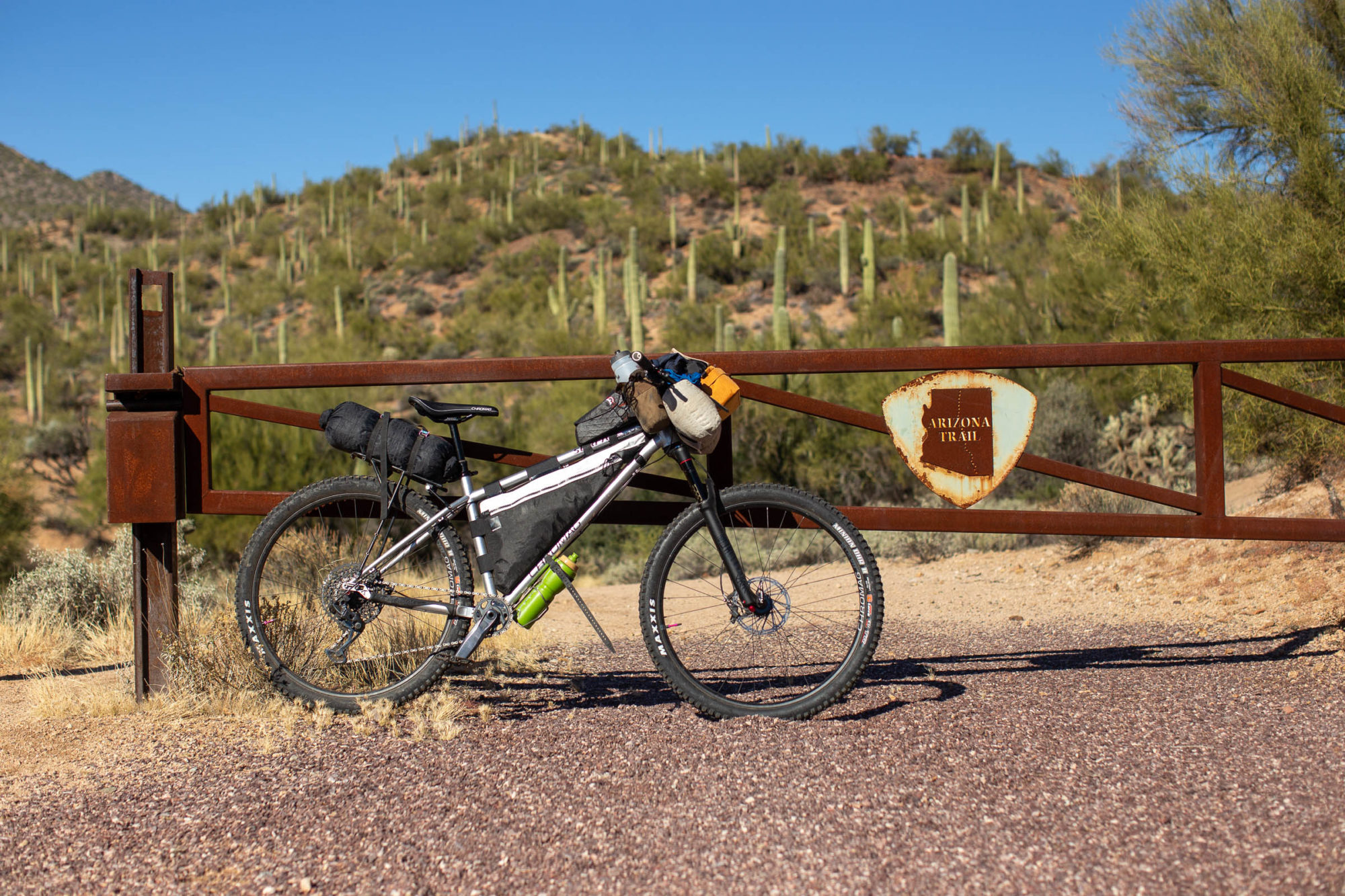
First Ride Impressions
Thinking back to some of my first few rides back in the winter, a few things stood out for me. It felt long and heavy and the front end seemed high. Let’s break those down. The long wheelbase is a product of the Voyager’s long reach and slack head tube. The resulting wheelbase ends up being between 30mm and 45mm longer than some other semi-rad hardtails I’ve ridden, and it’s noticeable. On tight switchback climbs, I initially struggled to make the turns and would often run the front tire off trail before making the corner. On descents, the long wheelbase seemed sure-footed and felt most natural leaning hard into corners. Offset by its generous stack height, my riding position felt comfortably upright in the flats and climbs and made it easy to shift my weight backward on steep descents.
The weight plays a part in these first impressions. The build Chromag sent won’t appease weight weenies and instead leans into what they know best: rowdy, durable, and functional components. At 33.4 pounds (15.1kg), it was a full pound heavier than the Panorama Taiga and two pounds heavier than the Esker Japhy. While the enduro-ready build plays a big role in this, the frame’s beefy stature is hard to ignore. The non-drive-side chainstay/seatstay bridge, CNC machined Yokel, and thick tubing are all signs that the Surface Voyager is capable of much more than your average bikepacking trip. It didn’t take long to realize the Voyager felt most natural pointed downhill.
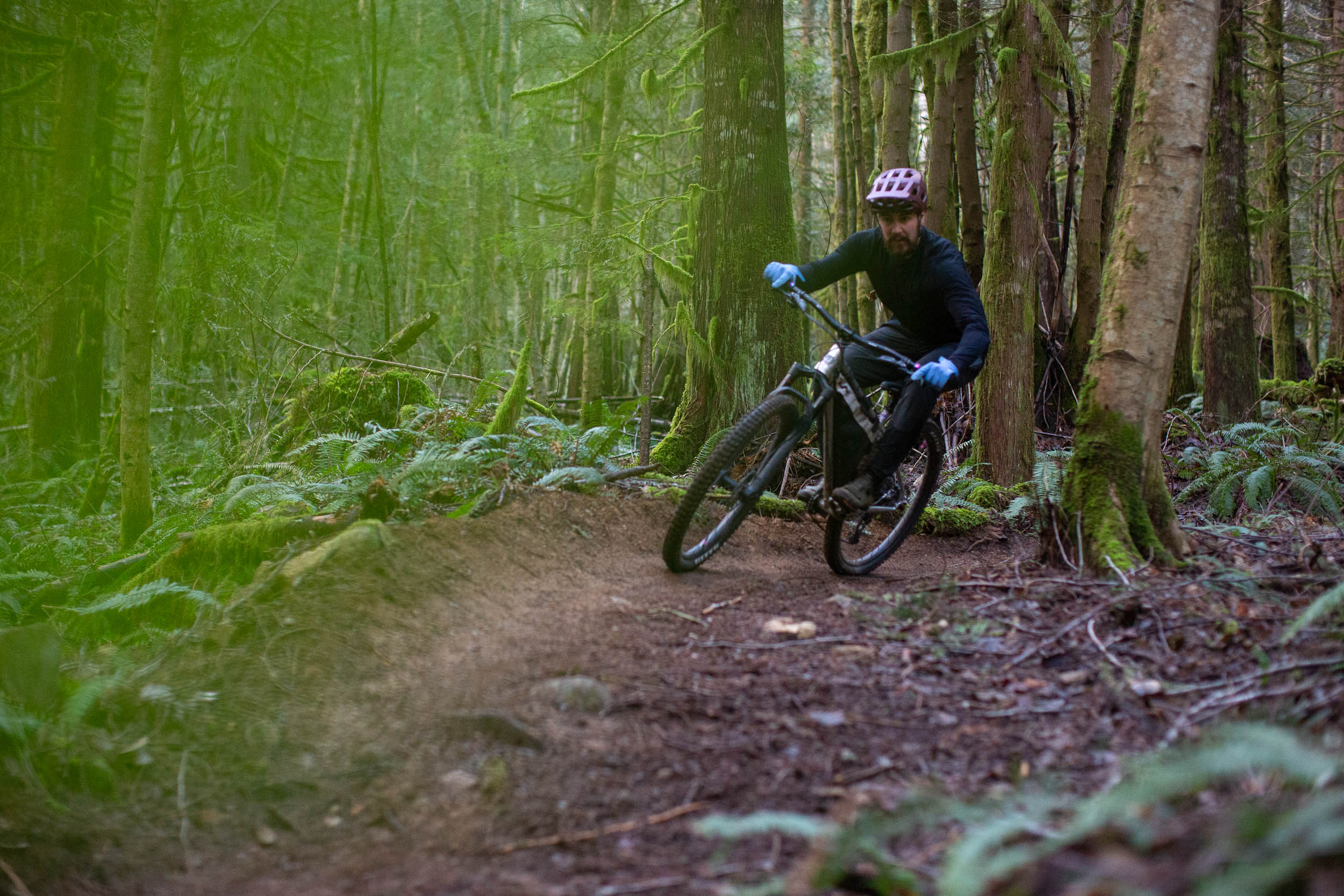
Chromag Surface Voyager Build Kit
As mentioned, the build kit Chromag sent me is a take on their G2 Better Build, and it was determined by what was available at the time. As expected, Chromag decked out the complete build with lots of their own components, including bars, stem, hubs, rims, saddle, and it even came with their own rigid seatpost, which I immediately swapped out for a 210mm OneUp dropper post. My test bike came specced with a RockShox Yari instead of the higher-end Pike. They sent their BA30 wheels, their most burly rim option, instead of their slightly lighter Phase30 wheels. It comes built up with a SRAM GX 12-speed drivetrain, a reliable set of SRAM G2 RSC hydraulic brakes, and the popular Maxxis Minion DHF/DHR tire combo. While Chromag specs the Surface Voyager with 29 x 2.4″ tires, they claim it plays nicely with up to a 29 x 2.6″ or 27.5 x 2.8″ tire as well. I had the chance to test fit both and can confirm that there’s plenty of clearance in both setups and wouldn’t be surprised if some 27.5 x 3.0″ and 29 x 2.8″ tires fit too. There was a solid half-inch or more of clearance near the bottom bracket and seat stays in 29 x 2.4″ mode.
G2 Better Build Kit
- Frame 4130 Chromoly Steel
- Fork Rock Shox Pike Select+ 140mm
- Crankset SRAM GX
- Shifter SRAM GX Eagle
- Cassette SRAM GX Eagle, 10-52T
- Derailleur SRAM GX Eagle 12-Speed
- Chain SRAM GX Eagle 12-Speed
- Bottom Bracket SRAM DUB BSA, 73mm Threaded
- Rims Chromag 29″ Phase30
- Front Hub Chromag R4 110x15mm
- Rear Hub Chromag R4 148x12mm
- Tires Maxxis Minion DHF/DHR 29×2.4″
- Brakes SRAM G2 RSC
- Brake Rotors SRAM Centerline 180mm
- Handlebar Chromag OSX 25mm Rise, 800mm
- Stem Chromag HiFi 40mm
- Seatpost Rock Shox Reverb or OneUp Dropper V2
- Saddle Chromag Trailmaster DT
- Headset Cane Creek Forty ZS
Under normal circumstances, I’d expect most buyers would build the Surface Voyager up from a frame, but considering the current (un)availability of parts, Chromag’s G2 Better Build Chromag is a solid option. It’s not overly flashy, but is thoughtfully curated for big days and challenging terrain. This was my first experience riding Chromag’s BA30 wheels, and they definitely proved their durability after several harsh rim strikes. It turns out a 2.4″ tire requires a little more pressure than what I’m normally used to. Chromag’s R4 hubs ran smoothly and trouble-free for the entire test period, although I would have benefited from a faster engaging rear hub on some of the more technical terrain I encountered. The thread on rear end caps, proven four pawl design, and availability of service parts does make them pretty appealing from a bikepacking perspective, though.
While Out Shredpacking
While the first couple of months of my test period were spent riding unloaded singletrack here in Powell River, my spring shaped up to be one jam-packed with bikepacking. In December, I travelled to Arizona to ride the Queen’s Ransom, a 227-mile route packed full of chunky singletrack and big climbs. In March, I returned to Arizona again to ride the Black Canyon Trail with Emily for my birthday, and a few weeks later I took off from Farmington, New Mexico, to scout the new San Juan Space Jam route. The majority of my ride time was spent loaded up with bikepacking gear tackling singletrack-heavy routes.
Beyond the reasonably sized main triangle that Rockgeist filled with a custom frame bag and the benefits of dedicated rear rack mounts I often secured my Tumbleweed T-Rack to, the Surface Voyager appears like a bike that wants to shred more than anything. However, it turns out some bikes can shred and pack. I found the bike to handle the weight of racks, bags, and gear naturally and comfortably. On the downs, it felt poppy and playful, and the extra weight pushed the bike through berms and into rollers in a surprisingly lively way. I can’t remember the last time I caught air so many times on a loaded bike, surprising even myself at times.
On the climbs, my initial impressions held true. Unloaded, the long/slack front end had a tendency to wander unless I was actively weighting the front end. This is nothing new and is the reality of riding long bikes. A loaded handlebar bag actually helped tame the front end and allowed me to push up and over chunks and slabs that would have been more challenging on a shorter bike. I was surprised at just how well the Surface Voyager climbed. While it wasn’t the most agile at low speeds, it bulldozed its way through small step-ups, rock gardens, and other trail features without hesitation. Sure, the weight of the build wasn’t making things easier, but it always felt solid and stable.
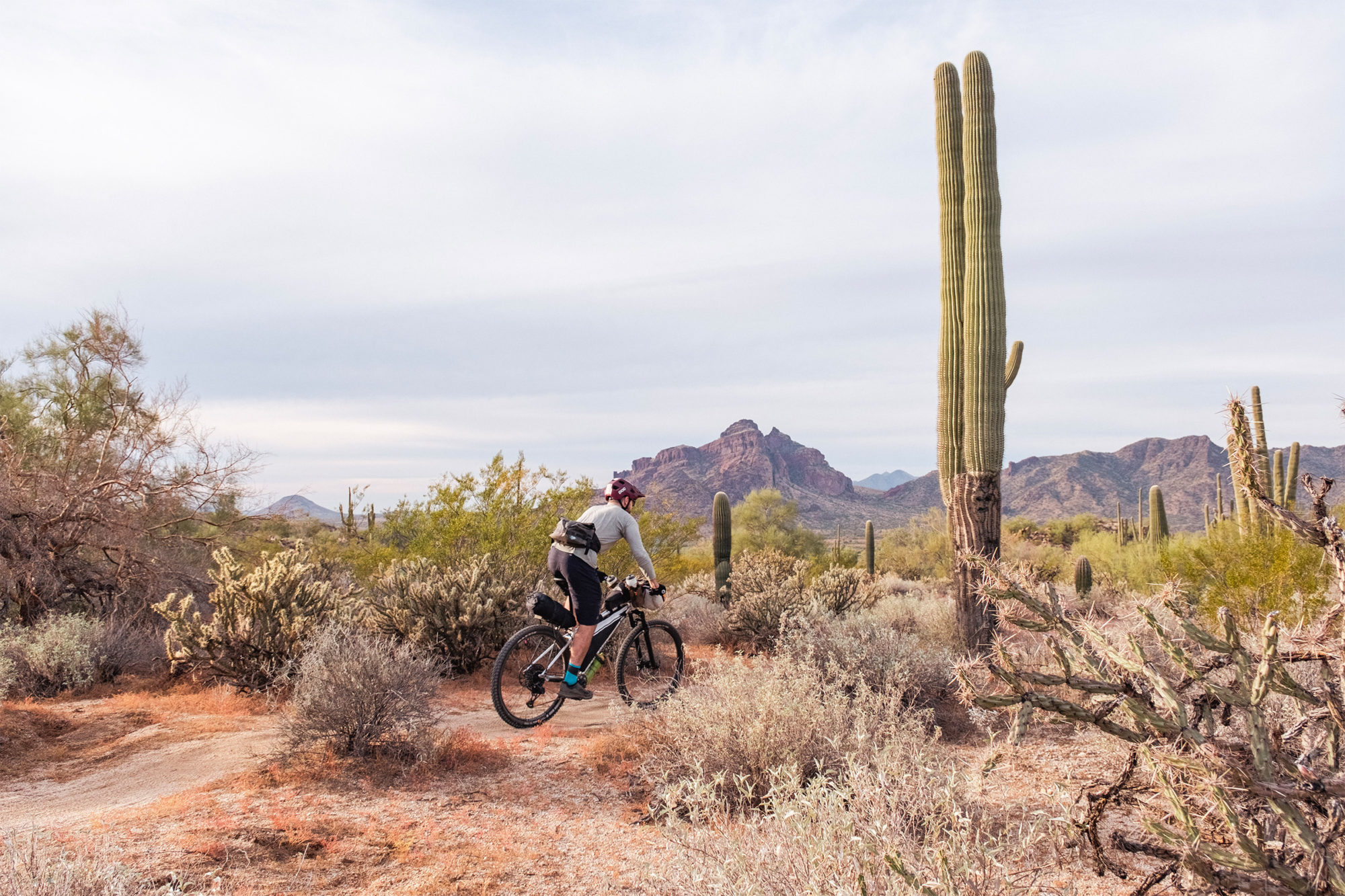
For What and For Whom
It turns out modern rowdy hardtail geometry isn’t just for bombing down black lines on the North Shore. In fact, I’ve grown to appreciate the long reach and tall stack for just about every type of ride I’ve been on. It puts me into a more upright riding position, even without the helping hand of big riser bars, and that’s something I appreciate when I’m spending more than a few hours on the bike. I never felt locked into an aggressive position, even though some folks may categorize it as an aggressive bike. A steeper head tube angle would definitely provide a more efficient ride on gravel roads and doubletrack, but I found that to be a small sacrifice for how much fun it afforded on the descents. Once it gets moving, it wants to keep moving. It just takes a little extra effort to get it there.
Eventually, I found myself pointing the front end down steeper, more technical lines without much thought. Between the progressive geometry and enduro-rated components, I doubt I was ever close to finding the bike’s limits. A few times, however, I was damn close to finding mine. In the end, it’s a lot of bike, and it likely isn’t going to be the best choice for anyone who isn’t looking to tackle aggressive, high-speed descents. There’s also a price that comes with a made-in-Canada frame and the reputation that comes with the Chromag name, so I can’t help but feel like those who might fit the Surface Voyager probably already know who they are. A few years ago, I wouldn’t have put myself into that category, but as my mountain bike skills have progressed and my appreciation for North American-made goods has increased, I’d jump on the opportunity to keep riding the Surface Voyager if I had the cash lying around.
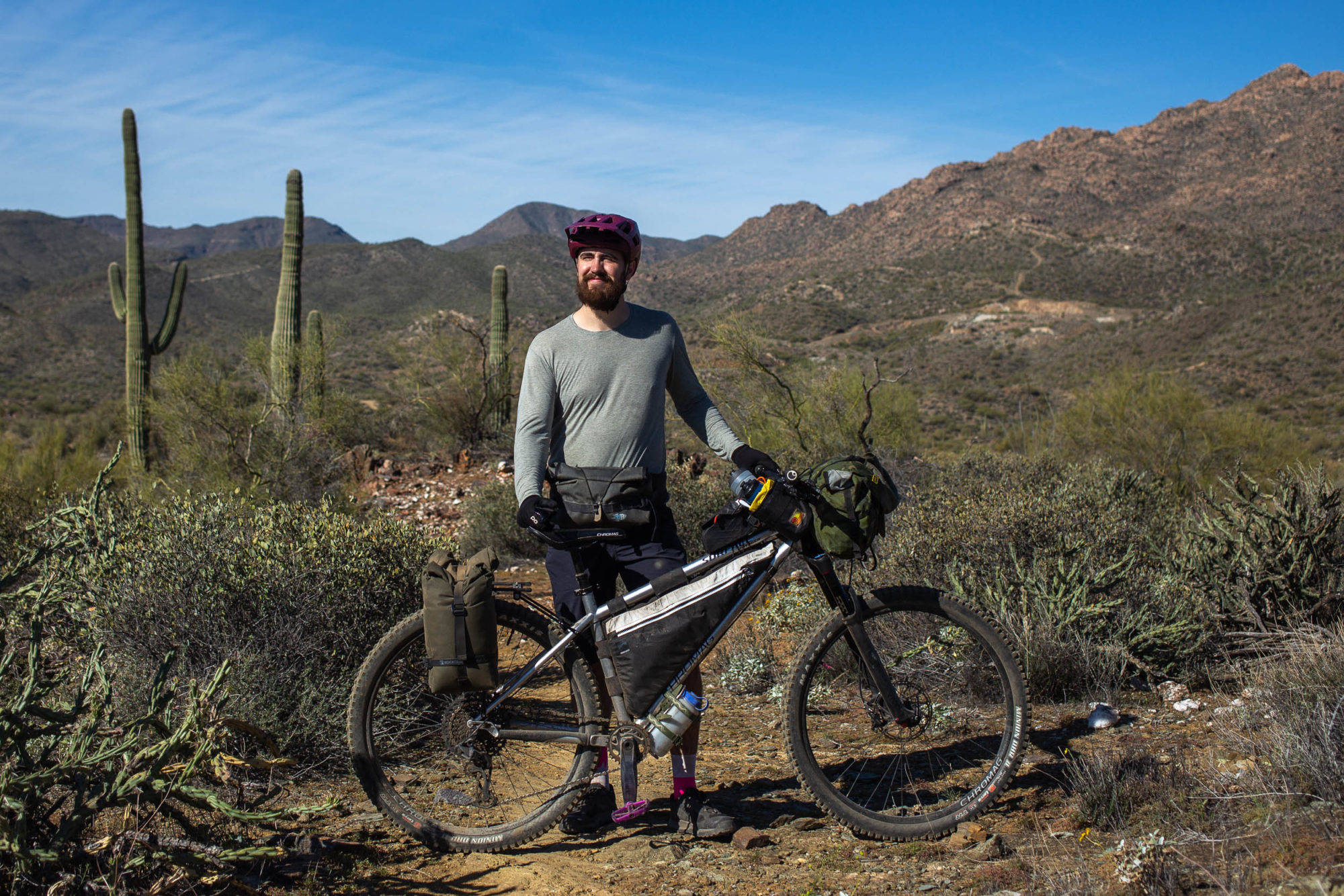
Splitting Atoms
For the modern shredpacker, the Surface Voyager has a lot to offer. Most of my grumbles were associated with the weight and length of the bike, which aren’t that surprising considering Chromag’s reputation for rowdy hardtails. While they obviously wanted to keep on brand, I think there was some room to push the bikepacking potential a little further. I would have traded a higher top tube and less standover for more frame bag space. This would probably open up the potential for an additional bottle mount on the seat tube, giving the option to run a wedge-style frame bag and large Nalgene or Klean Kanteen—a configuration I’ve come to appreciate more and more.
If I’m really getting picky, I have to admit I’m not a huge fan of the silver paint job on the test bike Chromag sent me. Considering all Canadian-made frames include a single colour (gloss finish, not matte or flake) and black or white decals, but also have the option for completely custom paint jobs, I found it to be somewhat lacklustre. The burnt orange and gold frames on Chromag’s website feel more special to me.
Lastly, it would be great to see a handmade-in-Taiwan option to make the Surface Voyager more accessible. All of Chromag’s other Taiwanese made frames retail for under $1,000 CAD, while the Canadian-made Surface Voyager frame costs $2,480 CAD. This makes it the most expensive steel frame in their current lineup. It’s also the only one with multiple bottle mounts, rack mounts, sliding dropouts, and a head tube angle steeper than 64°.

Pros
- Well-balanced geometry for those who want to shred, bikepack, and shredpack
- Bikepacking-friendly features like sliding dropouts, rack mounts, and lots of bosses
- Reasonable main triangle space for a frame bag
- Clearance for 29 x 2.6″ tires
- Handmade in Canada
Cons
- Heavy build will be overkill for most bikepacking needs
- No seat tube bottle mounts
- Expensive, but justified
- No handmade-in-Taiwan option
- Availability is uncertain and frames are made in small batches
- Model / Size Tested: Chromag Surface Voyager, Size Large
- Weight as tested: 33.4 pounds (15.1kg) with flat pedals
- Place of Manufacture: British Columbia, Canada
- Price: $2,480 CAD (frame only) / $6,000 CAD (G2 Better Build)
- Manufacturer’s Details: ChromagBikes.com
Wrap Up
People were understandably pretty excited about the release of the Surface Voyager last summer. It had the Chromag-curious among us, myself included, swooning at the possibility of a more bikepacking-friendly option from a brand with such deep roots in the Canadian mountain bike scene. Riding all-mountain trails on a hardtail is one thing, but showing up on a Chromag earns the respect of industry veterans and new-age shredders alike.
In the end, the Surface Voyager checks a lot of boxes from both a bikepacking and trail riding perspective. The folks at Chromag have clearly been keeping a close eye on what we bikepackers like to see, because sliding dropouts, rack mounts, multiple bottle mounts, and even top tube bosses, are all appreciated. The fact that most of this is new tech within their current lineup makes it that much more sweet. Although it has the tendency to feel like a tank, especially when loaded up and tackling big climbs, it makes up for that when momentum or gravity are at work. The Surface Voyager is the perfect bike for those who want an incredibly capable trail bike, a rowdy bikepacking bike, and appreciate the Chromag name.
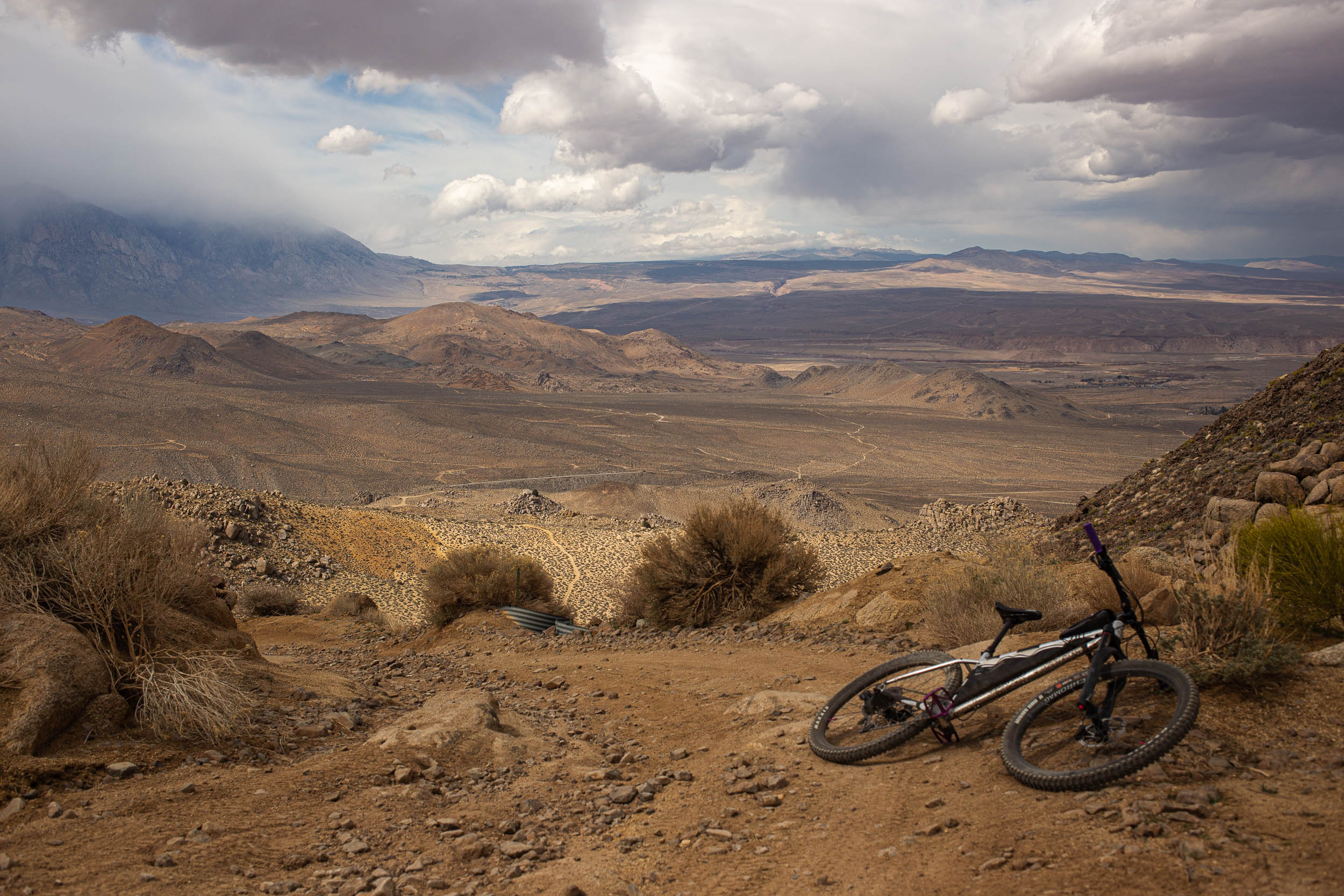
Related Content
Make sure to dig into these related articles for more info...
Please keep the conversation civil, constructive, and inclusive, or your comment will be removed.






